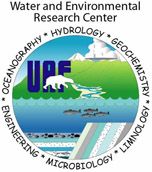

 |
 |
||
 |

Intersections of water, |
||
Water Resources: quality and quantity
A good water resource needs to be of adequate and reliable quantity and quality. These aspects of water resources were considered during visits to the study communities during the summers of 2004 and 2005 as well as the end of winter and fall of 2006.
While microbiological quality of raw water for a treatment plant is important, source quality is vital when water is untreated, as is common among traditional sources in many Alaskan communities. Samples from various water sources in Elim, Golovin, Teller, Wales, and White Mountain were tested for total coliform and E. coli in June and July 2005. While total coliform can be considered acceptable and expected in untreated water, E. coli is indicative of fecal contamination and should not be present in drinking water. One water source from each of those communities was also tested for Giardia lamblia and Cryptosporidium parvum. Giardia and Cryptosporidium are pathogens, and should be absent from drinking water. Giardia ('beaver fever') is a common concern for untreated surface water, and can spread from infected beavers that build dams in streams used as water resrouces. Results of microbial anlayses were presented to the communities and are being used in an index of current suitability for water sources.
The electrical conductivity of water reflects the amount of salts dissolved in the water. Rainwater will have low conductivity (~ 0 - 50 µS/cm), but as water comes into contact with mineral materials, more is dissolved in the water and conductivity rises to the hundreds of µS/cm. The electrical conductivity of groundwater depends on the type of bedrock and aquifer material as well as the residence time of the water in the ground. Conductivity is also increased when seawater intrudes freshwater aquifers and streams. Saltwater intrusion of coastal aquifers makes groundwater non-potable and tidal intrusion of the lower reaches of rivers can create brackish zones unsuited for drinking. Electrical conductivity was therefore measured for two purposes as a part of this project. Conductivity reflects current water resource suitability in that drinking water should be approximately within the range 50 - 500 µS/cm. Conductivity also reflects water resource reliability in that surface water of very low conductivity is likely heavily dependent on the precipitation and shallow groundwater contributions to its total quantity. Surface water with significant groundwater contribution and groundwater that is deep or characterized by a long residence time tend to have higher conductivities. Water resources with conductivity on the higher end of the acceptable drinking water range are therefore expected to be more reliable in dry years and in the coming century.
Electrical conductivity was measured by UAF researchers during the summer of 2005 and the late winter of 2006 and by community participants through the rest of the year. By measuring stream conductivity under the ice at the end of winter and assuming that all flow at that point is baseflow, or groundwater discharge, we can estimate what percent of flow at other times of year is groundwater and what is from precipitation and runoff by the following equations:
Qb + Qs = 1
Qs = (C – Cb)/(Cs – Cb)
Where:
Qb = proportion baseflow
Qs = proportion stormflow
Cb = baseflow conductivity (winter)
Cs = stormflow conductivity
C = stream conductivityConductivity and microbial quality parameters are assigned a rank for use in indices that summarize the current suitability and future vulnerability. Water sources can then be described by an index value that indicates current suitability. Current suitability is a function of conductivity and biological quality.
This material is based upon work supported by the National Science Foundation under Grant No. OPP-0328686. Any opinions, findings, and conclusions or recommendations expressed in this material are those of the authors and do not necessarily reflect the views of the National Science Foundation. UAF is an affirmative action/equal opportunity employer and educational institution. The University of Alaska Fairbanks is accredited by the Northwest Commission on Colleges and Universities.
|
_